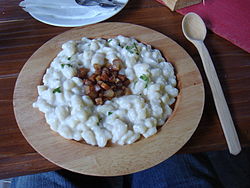This article needs additional citations for verification .(July 2008) |


Slovak cuisine varies slightly from region to region across Slovakia. It was influenced by the traditional cuisine of its neighbours and it influenced them as well. The origins of traditional Slovak cuisine can be traced to times when the majority of the population lived self-sufficiently in villages, with very limited food imports and exports and with no modern means of food preservation or processing.
Contents
- Slovak dishes
- Soups and sauces
- Meat
- Traditional sweets and cookies
- Main daily meal
- Books on Slovak cuisine
- See also
- References
- External links
This gave rise to a cuisine heavily dependent on a number of staple foods that could stand the hot summers and cold winters. These included wheat, potatoes, milk and milk products, pork, sauerkraut and onion. To a lesser degree beef, poultry, lamb and goat, eggs, a few other local vegetables, fruit and wild mushrooms were traditionally eaten.
All these were usually produced and processed by families themselves with some local trade at the country markets. Wheat was ground, and bread, dumplings and noodles were made from it. Potatoes were mostly boiled or processed into potato dough. Milk was processed into a wide range of products such as butter, cream, sour cream, buttermilk, and various types of cheese etc.
Typical pork products include sausages, smoked bacon, and lard. Spices were not widely used, and animal fats and butter were used instead of cooking oils. Main beverages included fresh and sour milk, and beer. Contemporary Slovak cuisine is widely influenced by various world cuisines and uses many different ingredients, spices and industrially processed foods.








